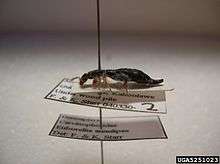Anisolabididae
Anisolabididae is a family of earwigs, in the suborder Forficulina and the order Dermaptera. It is one of nine families in the suborder Forficulina, and contains thirty-eight genera spread across thirteen subfamilies.
| Anisolabididae | |
|---|---|
 | |
| An adult Euborellia annulipes, or Ringlegged earwig, taken in Gunfire range, Kahoolawe, Hawaii, United States. | |
| Scientific classification | |
| Kingdom: | Animalia |
| Phylum: | Arthropoda |
| Class: | Insecta |
| Order: | Dermaptera |
| Superfamily: | Anisolabidoidea |
| Family: | Anisolabididae |
| Subfamilies [1][2][3][4][5] | |
See text for genera. | |
Subfamilies
The family contains the following subfamilies:
- Anisolabidinae (contains 25 genera, cited by both Srivastava and Chen & Ma.[6][7] Steinmann[8] in 1986, 1989, 1990, and 1993 classified the genera under the subfamilies Carcinophorinae and Gonolabiinae, which are synonyms of Anisolabidinae.[9] Other synonyms include Placolabidinae and Titanolabiinae. The genera in this subfamily are Aborolabis, Anisolabella, Anisolabis, Apolabis, Capralabis, Carcinophora, Epilabis, Epilandex, Euborellia, Flexiolabis, Foramenolabis, Gonolabis, Mongolabis, Placolabis, Gonolabina, Gonolabis, Heterolabis, Indolabis, Metalabis, Neolabis, Ornatolabis, Paraflexiolabis, Thekalabis, Titanolabis, and Zacheria)
- Anophthalmolabiinae (contains one genus, Anophthalmolabis, cited by both Steinmann and Srivastava[6][8])
- Antisolabiinae (contains one genus, Antisolabis, cited by both Steinmann and Srivastava[6][8])
- Brachylabinae (contains three genera: Brachylabis, Ctenisolabis, Metisolabis. Ctenisolabis and Metisolabis were cited by both Steinmann and Srivastava,[6][8] while Brachylabis was cited by Steinmann, Srivastava, and Chen & Ma[6][7][8])
- Idolopsalinae (contains one genus, Idolopsalis, cited by both Steinmann and Srivastava[6][8])
- Isolabiinae (contains four genera: Africolabis, Geracodes, Isolabis, and Pterolabis, cited only by Steinmann[8])
- Parisolabiinae (contains two genera, Parisolabis and Parisopsalis. They were cited by both Steinmann and Srivastava[6][8])
- Platylabiinae (contains one genus, Platylabia, cited by Steinmann, Srivastava, and Chen & Ma[6][7][8])
Incertae sedis:
The genus †Toxolabis was described in 2014 from a single fossil male recovered from Burmese amber. The single species T. zigrasi matches that of Anisolabididae members. Due to the quality of the preservation, the describing authors were not able to be determine a more specific placement within the family.[10]
gollark: I still don't think anyone's made audio or video languages but I haven't worked out how to make those interesting.
gollark: Wow, all good ideas have been used I *guess*.
gollark: Plus self-modifying code.
gollark: You could make it switch branches for control flow or something.
gollark: This would actually be an excellent esolang.
References
- http://species.wikimedia.org/wiki/Anisolabididae
- http://www.faunaeur.org/full_results.php?id=11932
- https://www.itis.gov/servlet/SingleRpt/SingleRpt?search_topic=TSN&search_value=102460
- http://sn2000.taxonomy.nl/Taxonomicon/TaxonLinks.aspx?id=147033&syn=1%5B%5D
- http://134.60.85.50:591/Earwig_online/FMPro?-db=systematics.fp5&-format=systematicsn%5ferg.html&-lay=standard&-sortfield=select%20...&Family=Anisolabididae&-find=%5B%5D
- Srivastava Fauna of India Pt. 2
- Chen & Ma 2004 Fauna Sinica
- Steinmann 1986, 1989, 1990, 1993
- Haas, Fabian (1996-07-18). "Dermaptera. Earwigs". The Tree of Life Web Project. Retrieved 2009-06-21.
- Engel, MS; Grimaldi, D (2014). "New mid-Cretaceous earwigs in amber from Myanmar (Dermaptera)". Novitates Paleoentomologicae. 6: 1–16.
External links
- The Earwig Research Centre's Anisolabididae database Instructions: type Anisolabididae in the "family" field and click "search".
- A drawing of the species Titanolabis colossea
This article is issued from Wikipedia. The text is licensed under Creative Commons - Attribution - Sharealike. Additional terms may apply for the media files.